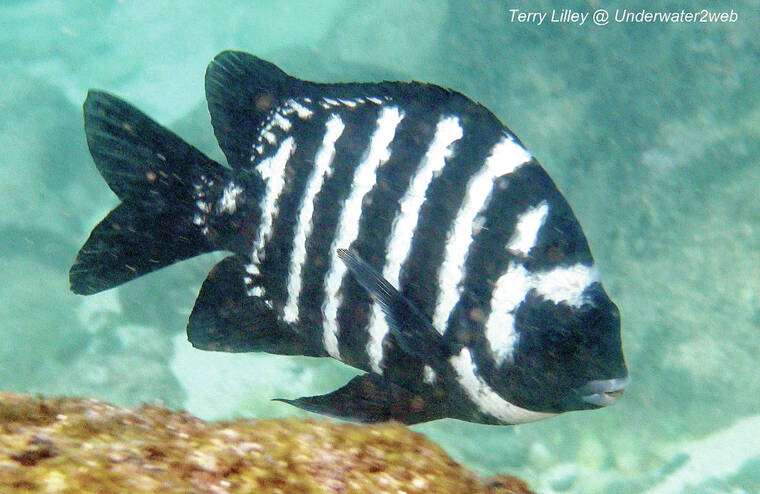Spring is here and love is all around, even for the fish! From birds to geckos, animals often change colors and behaviors this time of year to attract a mate for breeding. It is easy to watch a bird in your yard change into its breeding colors, but it is not so easy to watch a fish in the sea change into its breeding colors, especially when it may do so for only three days!
We can also easily hear our songbirds sing to each other, but we are finding out that many fish do the same when it is time to breed. It just has not been easy to place equipment underwater to record the songs of our marine life, but with Scripps Institute of Oceanography we did just that at Makua (Tunnels) Beach on Kaua‘i’s North Shore. What we found was just stunning.
We put out on the reef at 40 feet deep a plastic platform with six arms that looked like a white octopus. On each arm was a camera that took a picture with a flash every few seconds. On each arm was also mounted an acoustical monitoring device that recorded all of the sounds in the sea near that part of the reef.
What we were looking for was the “acoustical footprint” of the reef in Kaua‘i, and we got was more than we bargained for!
The equipment was recording on the sea floor for two weeks, and it recorded over a billion sounds!
It turns out that the fish talk to each other, and they also talk to the lobsters and corals, which all talk to the dolphins and crabs.
Most of the reef species actively talk to each other, so the sea is not as silent as we once thought. We found out that a healthy reef has different songs than a sick reef, and we now can analyze the condition of a coral reef by its song. This helps us know if a reef system is becoming sick, just like if you are a professional singer and sing in a local bar when you are catching a cold you will sing differently!
One of the interesting songs on the reef is being sung right now! Kupipi is a blackspot sergeant fish that is normally a dull gray or green with a black dot on its side. This fish is super common here in Hawaiian waters, is about five inches long and lives near shore. It is called a “sergeant fish” because it has bars on its side that resemble the stripes on a person’s uniform that is in the military.
But for about 36 hours, kupipi males turn jet black with white bars.
Most divers think they are seeing a completely different fish species.
The males establish a territory for only two to three days and chase off other males while making a figure-8 pattern over their patch of reef. When a female kupipi comes by she needs to choose the male that has the best figure-8 pattern but also the male that is singing to her! The males make a soft, vibrating noise that somehow attracts just the right female to come in and lay her eggs on his protected part of the reef.
Fish can be quite romantic when they want to.
Once the eggs are laid, the male fertilizes them and the female leaves, so he stops singing, and within a few days the male turns back to a drab gray color and the eggs hatch and swim off on their own.
We are finding that coral reefs and all of the amazing creatures that live there are very complex, and this is why it is so important to study the effects of manmade sounds that can throw off the entire “acoustical footprint” of a reef.
Movies like the “Sonic Sea” are looking at the effects of submarines, shipping containers, undersea oil exploration and mining and how those activities can alter our entire marine ecosystem in a negative way.
You can see kupipi in action on my underwater marine life web page at underwater2web.com and in our ongoing marine life movie series on our YouTube at Underwater2web.
•••
Terry Lilley is a marine biologist living in Hanalei. He is co-founder of Reef Guardians Hawai‘i, a nonprofit on a mission to provide education and resources to protect the coral reef. To donate to Reef Guardians Hawaii go to www.reefguardianshawaii.org.


